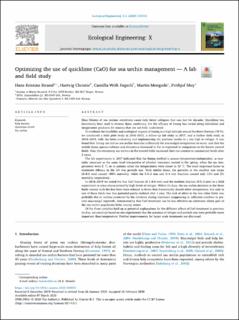| dc.description.abstract | Mass blooms of sea urchins sometimes cause kelp forest collapses that can last for decades. Quicklime has historically been used to reverse those conditions, but the efficacy of liming has varied along latitudinal and temperature gradients for reasons that are not fully understood.
To evaluate the feasibility and ecological impacts of liming in a high latitude area in Northern Norway (70°N), we conducted a field pilot study in 2008–2011, a follow-up lab study in 2017, and a further field study in 2018–2019, with the latter evaluating and implementing the previous results in a site high in refuges. It was found that liming can reduce sea urchin densities sufficiently for macroalgal revegetation to occur, and that the mobile fauna species richness and abundance increased in the re-vegetated in comparison to the barren control fields. Also, the remaining sea urchins in the treated fields increased their roe content to commercial levels after 2 years.
The lab experiments in 2017 indicated that the liming method is season/temperature-independent, as mortality remained at the same level irrespective of whether treatment started in the spring, when the sea temperatures were 2 °C, or in autumn when the temperatures were closer to 10 °C. The most important factor in treatment efficacy in the lab was particle size. With similar doses, the particles in the smallest size range (0–0.5 mm) caused 100% mortality, while the 0.5–2 mm and 2–4 mm fractions caused only 13% and 2% mortality respectively.
In 2018–2019 we tested the fine CaO fraction (0.1–0.6 mm) and the medium fraction (0.5–2 mm) in a field experiment in areas characterized by high levels of refuges. Within 11 days, the sea urchin densities in the three fields treated with the fine lime were reduced to levels that theoretically should allow revegetation, but only in one of those fields was that potential partly realized after 1 year. The lack of effect in the two other fields was probably due to urchins protected by the substrate during treatment reappearing in sufficient numbers to prevent macroalgal regrowth, demonstrating that CaO treatment can be less effective on substrates where part of the sea urchin population hides among stones.
Of the three variables held up as potential explanations for the different effects of CaO treatment in previous studies, we conclude based on our experiments that the presence of refuges and particle size were probably more important than temperature. Further improvements for larger scale treatments are discussed. | en_US |
